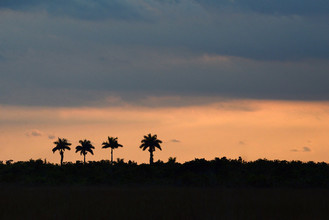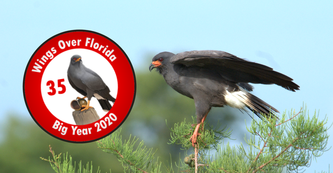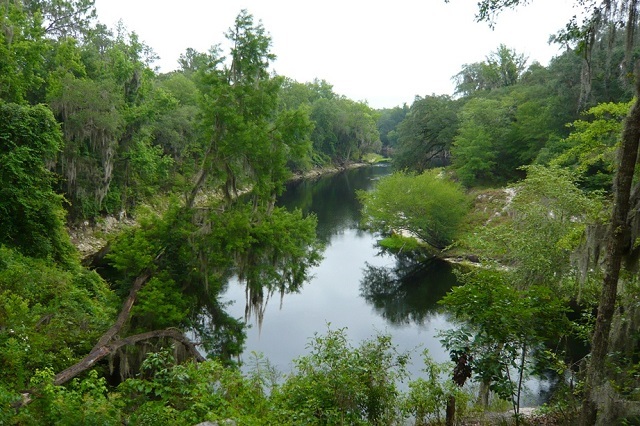 Sunset over Everglades National Park. FWC Photo.
As 2020 comes to a close, we want to thank each and every one of you for joining us on the Great Florida Birding and Wildlife Trail. This year has not been an easy one but many of us have found solace in nature during this otherwise chaotic year. Whether visiting Trail sites or watching backyard birds from our windows, quiet moments watching wildlife have been a calming oasis in time.
It has been a joy to share our love of Florida’s wildlife and natural spaces with all of you. We thank you for following along with us and wish you all the best for 2021.
Liz Schold, Travis Blunden and Anne Glick
FWC Wildlife Viewing Staff

Don’t forget to submit your application for your Wings Over Florida Big Year certificates! If you’ve seen at least 20 butterflies or 50 birds in the state of Florida in 2020 you are eligible to receive a gorgeous frame-worthy certificate with your name and the number of species you saw. Our 2020 certificates, featuring artwork by Chris Burney, highlight two iconic species: The Everglades Snail Kite and zebra longwing butterfly. You will also receive a Big Year button custom printed with your big year total so you can show off your accomplishment!
 Zebra Longwing butterfly. FWC Photo.
The iconic Zebra Longwing (or Zebra Heliconian) butterfly is a common sight across the state of Florida, with its unmistakable black and pale-yellow flashes as it flutters lazily through forested landscapes or among suburban yards and parks. While widespread and familiar enough to be an excellent choice for our state butterfly, its biology and behavior is anything but ordinary.
Adult Zebra Longwings have several interesting traits that set them apart from other butterflies. While most species only live for a few weeks after metamorphosis, this species can live for several months. Their longevity can be partially explained by a unique feeding habit – rather than only living off nectar, Zebra Longwings can also use their saliva to dissolve and eat pollen. These butterflies have been shown to be remarkably intelligent; they can remember their favorite flowers to feed on and return again and again. At night, they can be found roosting in communal groups of up to 60 individuals.
Like many butterfly species, Zebra Longwings only lay eggs on specific host plants – in their case, the purple passionflower (also known as maypop). Their small yellow eggs hatch into white caterpillars with black spots and lots of black spines. As the caterpillars feed on the plant, they incorporate some of the passionflower’s naturally produced toxins, which makes them taste awful to potential predators. Passionflower is a very easy to grow native plant with stunning purple flowers, so planting some in your garden is an excellent way to attract Zebra Longwings to your yard. For more information on using native plantings to attract wildlife, you can order FWC’s Planting a Refuge for Wildlife booklet.
The Zebra Longwing is also the featured image on our first level Wings Over Florida butterfly certificate. If you’ve spotted at least 10 butterfly species in the state, you can apply online today to receive your certificate in the mail.
 The scenic river trail is just part of a network of over 20 miles of trails at the Spirit of the Suwannee Music Park. FWC Photo.
This park and campground is a popular destination for music lovers, paddlers and wildlife watchers. Stop at the park office to pick up maps and to pay the admission fee. Twenty miles of hiking and multi-use trails are on offer. One of the park’s big attractions is a super-sized bat house inhabited by thousands of Brazilian free-tailed bats. The bat house stands in a field on the south side of the park; enjoy the bats emerging on most warm nights of the year. Bat watchers who are not camping can purchase an evening pass to witness this spectacle. The best birding area in the park is the scenic River Trail, which runs along the river’s limestone bluffs. The trailhead’s observation deck is a good place to scan for Mississippi Kites. In spring and summer, look for Acadian and Great Crested Flycatchers, Yellow-throated Vireo and Northern Parula. Around the fields, pines and upland woods in the southern half of the park, check for Eastern Bluebird, Summer Tanager and Yellow-billed Cuckoo. For a nominal launch fee, the Suwannee River Wilderness Trail can be accessed in the northwest corner of the park; paddle your canoe or kayak in either direction for a great experience. The park has a restaurant, rooms and cabins for rent and numerous RV and tent camping options. Bicycles and golf carts can be rented at the park’s Country Store; rent a canoe or kayak at the park’s Suwannee Canoe Outpost.
Nearest city: Live Oak/Jasper
Address: 3076 95th Dr., Live Oak, 32060
Hours: Daily, 8 a.m.-6 p.m
Phone: 386-364-1683
Website: MusicLivesHere.com

January 2 – STA 5/6 Driving Bird Tour (Clewiston)
January 9 – Birding Trip to Withlacoochee River Park (Dade City)
January 14 – Thursday Morning and the Matanzas Inlet with Peggy Cook (St. Augustine)
January 15 – Birding Trip to Sweetwater Wetlands (Gainesville)
January 16 – STA 5/6 Driving Bird Tour (Clewiston)
January 18 – Duval Audubon Society Monthly Program “Learning the Language of Birds” (Virtual)
January 21 – 25 – North Shore Birding Festival (Mount Dora)
January 22 – Beginning Bird Walk (Brooksville)
January 23 – STA 5/6 Driving Bird Tour (Clewiston)
January 28 – Birding Field Trip to Merritt Island (Titusville)
January 29 – Birding Trip to Lake Apopka Wildlife Drive (Apopka)
Do you know about any other bird or wildlife-related events going on in Florida? Help spread the word by letting us know! Send in the times, dates, locations and contacts to WildlifeViewing@MyFWC.com for posting on the Great Florida Birding and Wildlife Trail website.
Events must be related to birds or other wildlife and must be open to the public. Examples include field trips, interpretive programming, webinars, summer camps and family programs.
|